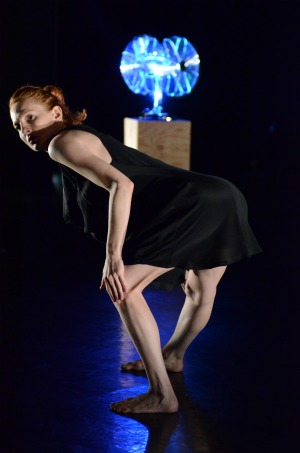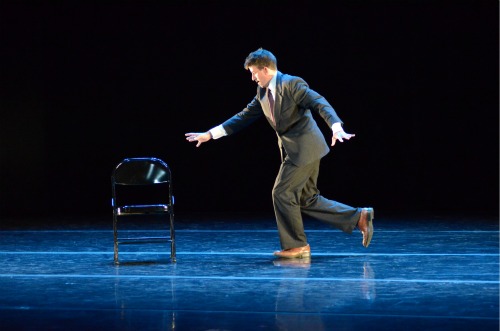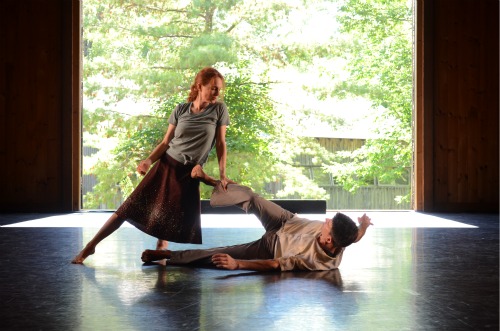When is a shadow not a shadow? That’s one of the mysteries of Jodi Melnick’s solo Fanfare(2009). Wearing a little black dress, her red hair fiery in Joe Levasseur’s lighting, Melnick inhabits a world within the Doris Duke Studio Theater at Jacob’s Pillow that’s otherwise all black and white, darkness and gleaming silver.
Burt Barr’s set design consists of two double fans set on squared-edged pillars about four feet tall. Little projectors on adjoining pillars glance bright beams off the fans as they swing from side to side, squeaking very softly. The intermittent silver blaze can dazzle you. At the back, the moving fans appear as dark shapes on a suspended, gray, two-panel screen. Watching them while waiting for the piece to start, you could swear you were seeing shadows; midway through Fanfare, you suddenly notice that the “shadows” have vanished. They must have been projections. Eerie.
Melnick is one of those great dancers who draws you into what she’s doing, instead of throwing it out to you. She moves gently, fluidly, patiently—occasionally hinting that she might turn mischievous or angry. She’s not one for a lot of footwork; she gestures, rearranges her body, walks around the territory. The image she projects is of a woman considering her moves, feeling the air, say, on the back of her arm as she slides it into another envelope of space.
You watch her closely. Facing away from the audience, she brings her right elbow toward her right hip, jutting the hip a little to meet it. She lifts her other arm to form a curve. Joel Mellin’s soft, sometimes gritty sound design slips in (sand being shaken, something being brushed). Everything Melnick does seems momentous, whether she’s pressing a hand against her cheek or making her fingertips meet.
She acquires a partner, Dennis O’Connor, who, side by side with her, copies her phrases. Their dancing takes them down to the floor and up again. No shadows or projections now—just the two fans, but unlike the dancers, they’re not moving in perfect sync. Their paths are the same; their timings gently wayward.
Melnick shared the program with David Neumann. Watching his very witty 2010 solo, Tough the Tough (Redux), you might wonder how these dissimilar performers had managed to collaborate on the last piece on the program. In Tough the Tough, Neumann is a wily Everyman set upon by a humdrum fate. Will Eno’s text (spoken soothingly on tape by DJ Mendel) introduces him as Mankind—let’s call him Steve. “It all comes down to this: Mankind is standing around.” Mankind also follows directions, tries to keep up with the important role assigned him. Neumann is a master of timing, of the small gesture, of the twitch of an eye. We laugh and laugh. It’s wonderfully sad.
Neumann’s Hit the Deck (Studies and Accidents) (2006), performed by members of David Neumann/Advanced Beginner Group, is somehow delicate in its absurdities and its rambunctiousness and brings him in some way closer to Melnick’s aesthetic. It’s a great pleasure to have a dance begin with a woman draped back over a chair seat and then have her turn out to be the very accomplished pianist. Carol Wong not only plays excerpts from works by Stravinsky extremely finely, she stops them obligingly or punches out a discord whenever small catastrophes happen in the dance or a change is signaled.
This is a piece in which people go offstage and, apparently, crash into a pile of chairs, where Neumann enters the stage just in time to catch a chair that’s thrown high by unseen hands. This is a piece in which a stoic non-dancer who might possibly by an assistant stage manager attacks the strings of the piano rather viciously, takes a bow for moving a chair, and then, later in the piece, sings so beautifully and so quietly in a high lyric tenor that your heart could break (he turns out to be Timothy Fallon of the Leipzig Opera). Natalie Agee, Kennis Hawkins, and Will Rawls come and go—dancing meditatively together, pausing often. Agee, dancing alone, finishes by lifting her circled arms and, arching way back, opening them to the sky. Then everyone leaves.
Now it doesn’t seem so strange that Melnick and Neumann should dance together. Their July begins with a magical vision. The back door of the barn theater is open to the night, and lights illuminate a big white pine that’s near enough to almost fill the opening. Nestled against it, a smaller tree or shrub shoots up a spray of slender stalks, its large leaves bright green against the pine’s blueish green. Melnick is standing at the rear of the stage staring at it, before she turns to walk a diagonal path to meet Neumann. The sounds we hear seem to come from far away—a machine of some kind, a dog barking, a snatch of music, peepers.
When the two begin dancing slowly together, they don’t move in unison, but the shapes they slip in and out of complement each other’s. They accommodate to the negative spaces carved between them—Neumann’s movements melting and becoming flexible in response to Melnick’s. And they do intersect—even, once, stumble together. Sometimes, without dropping a stitch, they’re in unison—a small miracle.
When they touch, you sense the heat, the questioning tingle of eroticism. At one point, he lies on the floor, ready to support her, and she leans, slanting out precariously over him, balancing her weight on his lifted leg or his hand. In the long moment before she suddenly drops her body onto his, you feel decision and non-decision meet and suspend.
July doesn’t really stop; the lights just go out on it. You could truthfully say that the piece is about two gifted performer-choreographers collaborating, finding ways to move together. If we see them as a man and a woman sensitively exploring their feelings for each other, that’s because, as artists, they present so beautifully something we wish we knew or think we know.




It is amazing to see a dancer whose performance quality renders pure focus from the audience. Whose most subtle gestures stirs the feelings of those who noticed it. The art of dance, the art of bodies in motion is something more people need to experience.